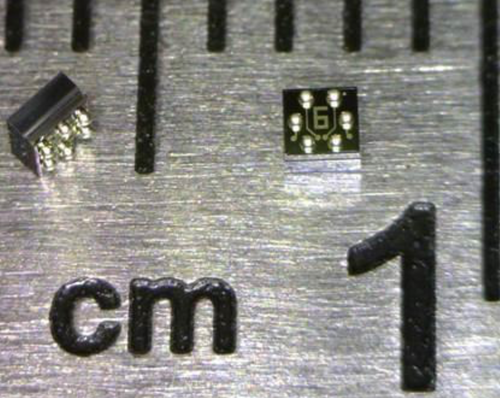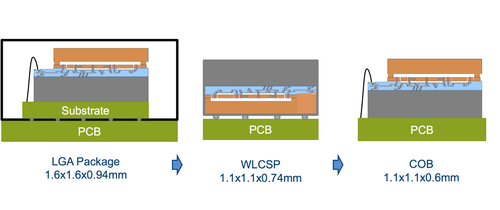PORTLAND, Ore.—Super-small inertial sensors,
like microelectromechanical system (MEMS) three-axis accelerometers, are
finding more-and-more uses in ultra-small Internet of Things (IoT)
devices such as wearables and industrial and medical devices such as
endoscopes that can navigate the smallest tracks, vessels and cavities
of our bodies. The mCube Inc. (San Jose, Calif.) 0.9 cubic millimeter
three-axis accelerometer—1.1-by-1.1-by-.74 millimeters—was designed
specifically for these applications, by making it 75 percent smaller
than the 2-by-2 and 3-by-3 millimeter accelerometers sold by its
competitors. Samples of mCubes world smallest three-axis accelerometer
will be shown for the first time at the MEMS Executive Congress 2015 (Napa, Calif., Nov. 4-to-6).

The
three-axis accelerometer from mCube is three years ahead of the
competition, according to analysts, at less than one cubic millimeter.
(Source: mCube, used with permission)
(Source: mCube, used with permission)
Symmetry is another principle that mCube follows, on the advise of the founding father of MEMS, Kurt Peterson who is famous for saying "symmetry is Godlike." The original mCube three axis accelerometer was 1.6-by-1.6, the current model is 1.1-by-1.1 and its next generation model will be symmetrically sub-millimeter, according to Lee. Peterson emphasizes symmetry because it allows MEMS devices—especially those stacking the MEMS atop the application specific integrated circuit (ASIC) on the same complementary metal oxide semiconductor (CMOS) chip to run without the compensation circuitry required by non-symmetrical architectures, especially those with the MEMS and ASIC on separate chips, according to Lee.

The
mCube vias between the ASIC and the MEMS on a single CMOS chip is
11-to-100 times smaller than the connections used by Invensense and
Bosch respectively
(Source: mCube, used with permission)
Click here for larger image
(Source: mCube, used with permission)
Click here for larger image
Instead of shrinking the proof mass, mCube has been going to smaller package architecture. For instance, its first 1.6 millimeter square MEMS was in a land-grid array package (LGA), the current 1.1 millimeter square device uses a Wafer Level Chip Scale Package (WLCSP) and its sub-millimeter model due out in the future will go to an even smaller chip-on-board (COB) package so small that it can be housed inside the IoT or medical device's application specific integrated circuit (ASIC) package.

The
first mCube three-axis accelerometer was in a land grid array (LGA)
package, but the current model downsized it by going to a wafer-scale
chip scale package and in the future mCube plans to downsize more to a
chip-on-board package that can fit inside other manufacturer's
systems-on-chip (SoCs).
(Source: mCube, used with permission)
Click here for larger image
(Source: mCube, used with permission)
Click here for larger image
http://www.eetimes.com/document.asp?doc_id=1328125
No comments:
Post a Comment